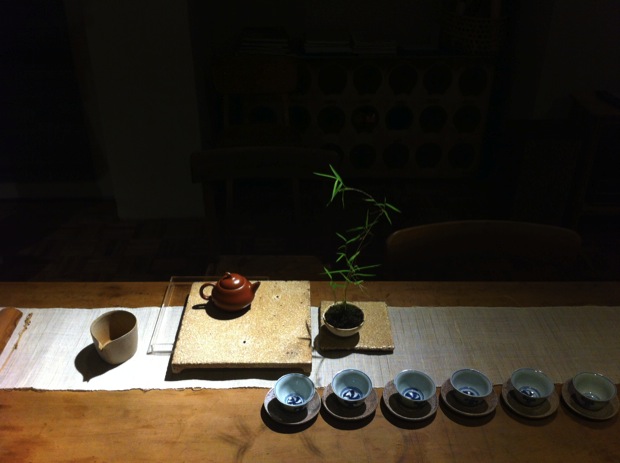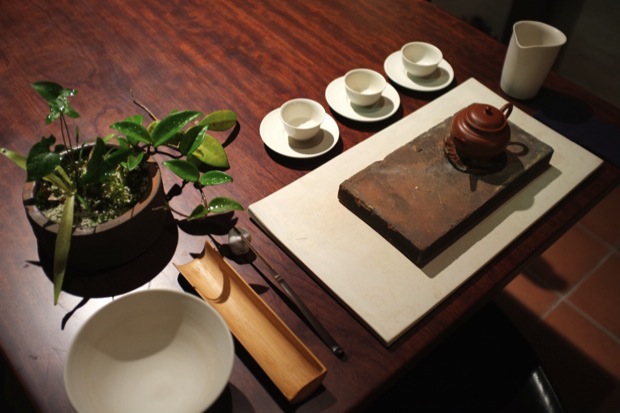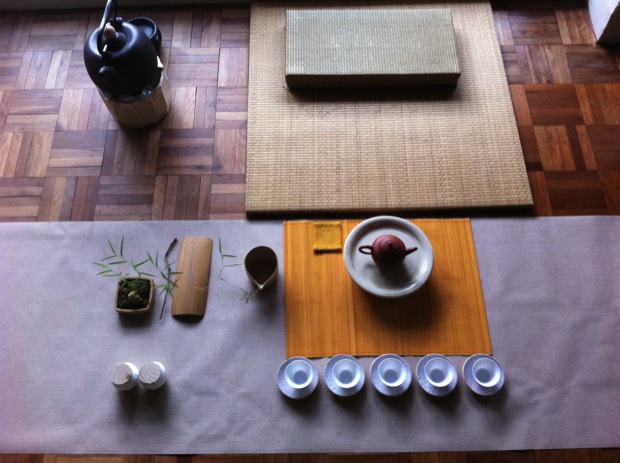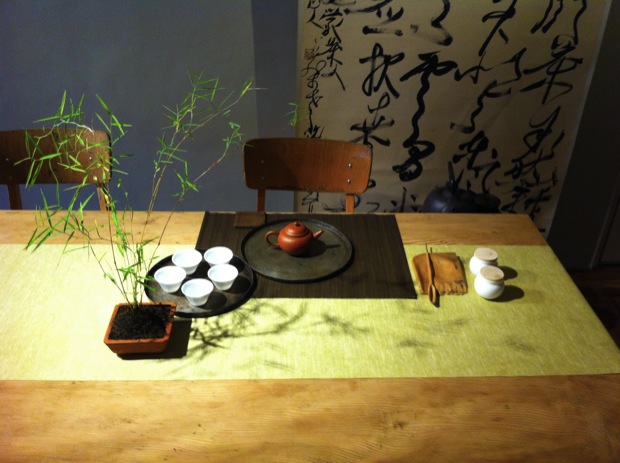|
|||||||||||
|
FEATURESFeeling Your Way The Cultivated Aesthetic in Taiwanese Tea ArtScott Writer Monash University*
This essay illustrates how the previously commonplace making and drinking of tea in the style of Gongfu cha which features elsewhere in this issue of China Heritage Quarterly has been in recent decades elevated into an art. The author studied and practice in a Taipei tea art academy in 2011-12 as part of ethnographic fieldwork in relation to a larger doctoral project on tea culture. The tea art chayi 茶藝 which he describes, now widespread in the People's Republic also, is another example of how over the years non-mainland aesthetic and consumer practices have profoundly changed living cultural habits in China proper.—The Editor As part of an idiomatic cluster of household essentials—'Oil, salt, sugar, vinegar, tea' 油鹽糖醋茶—tea is enshrined as inseparable from everyday life. 'Without tea, one is not a cultured person' 無茶不文人—here, by contrast, tea is emblematic of a refined life.[1] In contemporary Chinese culture there remains a disjunction between the mundane materiality of tea as a part of the everyday and its more hallowed role as a medium for moral self-cultivation. How can tea act as a lubricant between the ordinary and the exalted or, to borrow a distinction made by Gloria Davies, between how we exemplify the 'merely' and the 'properly' human?[2] It is in the context of 'tea art' 茶藝 in contemporary Taiwan and in the charen 茶人, or 'tea person'—an individual who seeks cultivation—through tea art practice, that I will consider this question. 'Tea art' emerged in Taiwan during the late 1970s as part of a wider revival of interest in local or vernacular 鄉土 cultures (in this context, see Linda Jaivin's essay on Wistaria Teahouse, also in the Features section of this issue—Ed.). It was popularized through the rapid spread of 'tea art houses' 茶藝館 throughout the island in the 1980s and 90s.[3] Tea art is grounded in the south-eastern tradition of Gongfu cha 功夫茶 tea drinking. It has now evolved into a diverse 'family' of connoisseurship practices. As tea art has developed practitioners have introduced modest but significant innovations to 'tea settings', such as the vogue in the 1980s and 1990s for tall and slender 'smelling cups' 聞香杯 and the introduction of an intermediary vessel 茶盅 which is used to store the tea poured from the pot before it is distributed to individual cups. Tea art practitioners have also broadened the aesthetic boundaries for tea connoisseurship by experimenting with elements of Japanese and Korean tea traditions and by holding large-scale public 'tea gatherings' 茶會 that incorporate music, dance and other aspects of the performing arts (with a standard of production design comparable to that of the leading exponents in these fields).
To enter into this community of tea art practitioners the student is expected to study three particular areas of expertise: 1. The design of the tea setting, or chaxi 茶席. This involves the selection and artful arrangement of the tea ware 茶具, including tea pots, bowls, cups and trays, as well as the use of fabric, plants or flower arrangements; 2. The comportment of the practitioner as they lead their guests through the process of brewing, serving and tasting the tea selected for the occasion, called in Chinese chaxu 茶序; and, 3. The tea itself—as a sensory experience produced through the skilled manipulation of materials in the hands of the mature tea art practitioner or charen. Learning this newly evolved tradition of tea art involves a process of sensitising oneself so as to apprehend and respond to each of these aspects of practice. A sense of cultivated personhood involving this ritualized approach to tea making and drinking elevates a seemingly mundane pursuit to the level of what is now celebrated as a 'way' 道 or dao. Here, rather than focus on any particular point in isolation, I would like to consider the interconnected nature of all three. The following account is based on my own experience of ethnographic fieldwork in a tea art academy in Taipei.[4] Things that Resonate: Tea and chaxi Fig.1
Creating a chaxi is an act of assemblage. The desired aesthetic effect is possible through the careful selection and arrangement of 'found' materials. In turn, the successful design of a chaxi hinges on the conjunction between a given set of tea ware and a particular tea. The focus of aesthetic attention in a chaxi is not simply on how each vessel or implement complements or sets off its neighbors, but rather how, individually and in concert, they collectively elevate the sensory potential of the tea being brewed. While for those attending a tea gathering each chaxi is primarily a visual experience, for the tea-art practitioner aesthetic considerations—for example, of visual harmony or delight 趣味—are secondary to practical concerns related to the material performance during the gathering. Questions considered by the practitioner include: —What should be used to brew the tea? A 'purple sand' 紫砂 clay teapot, a porcelain teapot, or a covered bowl 蓋碗? It is for the practitioner to modulate the resonances between different materials to create thereby a particular chaxi. At the heart of this kind of tea art practice, then, is the organic relationship between tea and tea ware. When these are in harmony the sensory-material trajectory of the tea leaves will be altered by the particular tea ware to produce the best possible 'tea liquor' 茶湯. As Xie Zhijiang 解致璋, one of Taiwan's foremost tea art instructors explains: The sincerity with which we serve our guests should manifest itself in the beautiful flavour of the tea. In designing a chaxi we cannot simply pay attention to visual appeal and ignore the depth [of flavour] of the tea… It is good tea ware—living tea ware—that produces a tea that can move us.[5] An Eye for Tea Fig.2
As to the tea itself, what kind of 'vision' or 'gustatory sense' is required to appreciate the sensory potentialities of the particular tea chosen? Lee Shuyun 李曙韻, another eminent tea art instructor, suggests the following: In appraising tea ware, the gaze of the charen does not depend on [background] knowledge of the objects. It is based on direct perception. Similarly when one tastes a tea, it is not necessary to look up its place of origin, the year in which it was picked or its producer. Good tea speaks for itself.[6] Lee's remarks highlight many of the hallmarks of Chinese tea connoisseurship: the categorisation of teas by their place of origin (Dong Ding 凍頂, Wuyi Shan 武夷山, and so on), the climatic variations during the growing season from year to year, the different flavour profiles produced by aged tea 老茶, and the distinctive processing techniques employed by different tea producers. But in this interpretation of the art of tea, such knowledge is secondary to that derived by a skilled understanding of the tea itself and close attention being paid to the material traces manifest in the tea leaves: 'good tea speaks for itself'. The standard classification systems popular in Taiwan—by place of production, by degree of oxidization, and so on—are here not sufficiently refined to impart to the practitioner of the art of tea an adequate sense of how they should respond to a particular tea at a given moment.[7] Rather, for Lee, a practitioner's encounter with objects and materials is akin to the experience of a Chan (or Zen) Buddhist adept, who 'drinking water, knows themselves if it is cold or warm' (如人飲水,冷暖自知).[8] A sensitivity to the life of materials also manifests in tea art practice as an appreciation of the inherent instability and dynamic nature of things. That is, objects are not seen as fixed and immutable, but rather as being material manifestations, trajectories that are to be choreographed by the charen. When speaking about the process involved in breaking in a new teapot, for example, Xie Zhizhang remarks that: Brewing tea with a new pot, the taste is bland and the fragrance lacklustre. But, once you have used it for some time the tea's taste will gradually improve and the body of the pot will slowly develop a lustrous patina. The longer it is used, the greater its fulsome elegance, and the more enhanced the tea's fragrance and mellow taste—something truly to be cherished. And by brewing tea and handling tea ware each day, our 'eye for tea' will be refined.[9] The 'vision' or 'eye for tea' of the charen is thus distinct from the mere visual; it is a practical understanding of how best to elicit the sensory potentialities of a tea, one that is developed by marshalling the material capacities both of tea vessels and of implements. The inherent possibilities of the objects used in the practice unfold as the charen becomes more adept, a process that in turn refines the aesthetic sensibilities of the charen. The Cultivated Aesthetic Fig.3
The tea master's repeated emphasis on the sensory-material capacities of objects helps us understand relative lack of interest in more abstract questions of beauty among tea art practitioners. When such questions do arise, they are most often left open; one appraises a tea implement for what it contributes to a particular chaxi rather than in abstract isolation. What is learned in tea art, then, is arguably not an 'aesthetic' but rather an approach to aesthetics—or better, poetics—that is based on the practitioner cultivating their sensitivity by building up a practical and sensory familiarity with different kinds of tea and tea ware. Xie Zhizhang expands on how such transformations of object and subject are wrought by tea art practice: Our eye [for choosing tea ware] improves with time and experience; tea ware that we thought was beautiful when we were starting out, might [later] seem gaudy or impractical, and so we cultivate our eye by learning from experience. As we do so, we can dispense with an over-eager mindset and proceed in a grounded and relaxed fashion. Gradually, something is revealed that is hard to perceive with the naked eye, and we come to appreciate a beauty that was previously invisible. With practice our understanding deepens; the appreciation of beauty cannot be learnt from concepts.[10] The concept of 'cultivation' 養 provides a common ground for talking about the agency of the tea art practitioner and of the materials with which they interact. The outcome of such cultivation is a transformation that bestows both vitality 養生 and cultural refinement 修養.[11] As they are used, the objects that make up the chaxi are gradually transformed; one 'cultivates' them (養茶具) by repeated use, and over time they take on depth and a patina, such that they embody the 'living tea ware' which Xie Zhizhang referred to earlier. At the same time, this process of cultivation imbues the charen with a finer appreciation of how to engage both with specific teas and with specific objects—which objects or materials produce a concord (through their sensory-material impact on the tea's taste and also in their visual complementarity or contrast for those making and drinking the tea), how to arrange specific tea ware and implements so that they are 'ready to hand' 順手. Through practice the tea maker overcomes their own aesthetic biases so that they can offer an apposite response to the demands or possibilities suggested by each new combination of tea and tea ware.[12] Practice refines the process, but it is one that by its very nature remains both provisional and open-ended. In the place of fixed aesthetic standards or guidelines, then, tea art practitioners substitute an attention to practice and a willingness to meet objects on their own terms: Tea liquor is an emanation of the interiority of the charen. Emotion and cultivation can both influence the expression of a tea, but a singular emphasis on the mental cannot grasp the feeling of ebb and flow contained in each tea. This [attitude] goes against the self-cultivation principle of 'with your heart-mind acting on the tea, through tea cultivating your practice'.[13] A tea art practitioner modulates their relationship between tea and tea ware each time they brew tea, through an ever-finer grasp of the 'nature of tea' 茶性 deepening their ability to use tea and tea ware as an expressive medium. The 'Art of Tea' 茶藝 and the 'Way of Tea' 茶道 Fig.4
The union of aesthetic and ethical cultivation in Taiwanese tea art discourse is not surprising when one considers that 'cultivation' implies a way of living. As we noted earlier, in the course of only a few decades Taiwanese tea art practitioners have been able to transform the commonplace practice of Gongfu cha tea making into something emblematic of cultural sophistication and proper comportment. As tea drinking was transformed from being just a 'local' practice to become a significant cultural pursuit its practitioners moved from the 'merely' to the 'properly' human. I suggest that this transmogrification, or 'transport', has been partly made possible by how tea drinking has been framed in terms of self-cultivation, something that in turn evokes the perceived tradition of literati or wenren 文人 culture. To get a sense of how tea art aims to elevate the everyday, let's consider another passage from Lee Shuyun, one in which she contrasts Taiwanese and Japanese tea practices: The chaxi leads the aestheticization of everyday life. Even without a dedicated tearoom and with just a tea tray and a patch of grass, in the hands of the charen the tea set can transfer 'the flavour of tea' [chawei 茶味, a term that recalls the concept of chanwei 禅味 [the flavour of a Zen-like meditative state] into everyday living spaces. Many people are enamoured of the Japanese chado, and attempt to emulate its visual symbolism. But creating a 'scene' 景 is easy, but generating an embracing environment 境 is far more demanding. Only through constant, daily contact with tea can you develop a personalized relationship with tea. A designer can only manufacture a 'scene', they can't produce an all-encompassing environment. If a space is not lived in, even the most meticulously constructed 'scene' will fail to produce a 'place' [or 'tea environment'].[14] 茶席在生活中扮演美學的先行者,即便沒有固定的茶室,只要一隻托盤一地草地,器具在茶人的指間指揮若定地鋪展開來,在日常地生活場域都能點化出些許茶味來。很多人嚮往日本茶道的視覺符號,而要求設計師複製符號表象的景觀。然而造景容易造境難,非得常日與茶獨處才能活出自己獨立的茶場域,設計師只能創造景而不能幫業主創造境。少了主任在現實空間中生活的軌跡,再成功的造景都無法進一步衍生出情境。 The production of a 'scene' is understood here primarily in visual terms while that of a 'place' or 'environment' is something characterized by affective intensity. For Lee, the charen is distinguished by an ability to generate a context that allows for an elevated feeling or aesthetic sense. The mere employment of a fixed repertoire of visual symbolism will not suffice. Rather, through the practice of 'cultivation'/yang 養, the elements of a chaxi and the comportment of the charen effect a kind of mutual actualisation. That is, the skill with which the charen elicits the semio-material capacities of tea and tea implements manifest the sensitivities proper to a cultivated person. Elsewhere, Lee uses the neologism 麁相 cuxiang to refer to this intertwining human and non-human agency. It is an expression that alludes both to the 'rough' or 'unhewn' 粗 cu sense of untrammeled delight 野趣 that animates a successful chaxi, as well as the uncalculating originality 初 chu of the charen whose natural and unaffected bearing allows each tea to 'speak for itself'.[15] Re-embodying the Grand TraditionAs we have seen, cultivating a sensitive response to the tea and tea ware is at the heart of tea practice. Further, such sensitivity is predicated on an ostensibly non-conceptual, spontaneous apprehension of the affordances of things by the charen. It is with this conjunction of spontaneity and sensitivity that today's tea art practitioners most powerfully evoke an allied image of 'proper' personhood—the 'literati' or wenren—whose model of aesthetic and ethical acumen the charen strives to embody. In his discussion of late-Ming culture, Joseph Levenson long ago made that case that the wenren was imagined to be an inspired amateur, a scholar-official whose supposedly casual dabbling in the arts nonetheless produced masterworks of painting, poetry and calligraphy. This caste of scholar-officials celebrated in particular what was called 'spirit-consonance' 氣韻: an aesthetic approach to creativity that spoke of an artist or writer's direct and spontaneous apprehension of, say, a landscape and their corresponding ability to give form to that perception through a painting or verse.[16] According to this particular account of the late-Chinese tradition (one that has become popular among elite Chinese cultural practitioners in Taiwan and elsewhere since the 1980s), the professional artist or artisan 工匠 was, by contrast, looked down on as being merely capable of mechanically reproducing received forms, their creations at best 'workmanlike' 匠氣 (a term that can also mean commonplace, unrefined or mediocre). With this in mind we can better appreciate the comparison that Lee Shuyun makes between the 'poetic eye that embraces a situation' 緊扣情境的詩眼 displayed in the works of the Song dynasty poet and artist Lin Hejing (林和靖, 967-1042) and the way that a charen 'evokes the self through objects' 藉物抒己的自況.[17] Here the poetic notion of zikuang—the metaphorical evocation of the self through the medium of material objects—provides us with an insight into the kind of 'vision' that is cultivated in tea art practice, one in which there is commingling of the animate and inanimate, the charen, the tea and the chaxi. Both the wenren painter and the charen use such direct apprehension—氣韻 qiyun—to call forth a poetic response. By cultivating such an attitude towards tea and tea ware, Lee argues, the practitioner can gain entrée via an empathetic understanding of the appreciation of tea masters or charen of antiquity, or as she puts it: 感應古代茶人愛器如斯的同理心.[18] The tea art practitioner's lived 'spirit-consonance' thus enables not only a communion with the non-human world but also entry into a temporal zone in which the unfolding present merges with a re-awakened past, where the perceived wenren tradition is renewed through the skilled practice of the charen today.[19] A 'consonance' 韻 between the timescape of tea making and the relived sense of tradition is translated into an embodied experience via taste 味. The 'enlivened spirit-consonance' 氣韻生動 , as it is called in traditional artistic terminology, of humans and the non-human is expressed through tea with a taste and a fragrance that can evoke an emotional response or 令人感動—the primary criterion for a successful chaxi articulated by Xie Zhizhang earlier.[20] By choreographing objects, bodies and emotions to produce novel forms of 'tasteful' experience, tea art practice is aimed at cultivating a sense of poetic personhood sensitive both to the call of the non-human and to the affective legacy of the charen's cultural precursors. Notes:* My thanks to Daniel Sanderson for inviting me to submit this preliminary work on tea in Taiwan to China Heritage Quarterly, and to the editor for his extensive revisions of the original draft. [1] The latter phrase is used as the title for a recent book discussing the place of tea in traditional and post-traditional literati 文人 culture. See Zhu Yuhua 朱郁华, Without Tea You Are Not a Cultured Person (Wu cha bu wenren 无茶不文人), Guilin: Guangxi Shifan Daxue Chubanshe, 2010. [2] Gloria Davies, 'Homo Dissensum Significans, or The Perils of Taking a Stand in China', Social Text, vol. 29, no. 4 (2012), p.30. [3] For a contemporary account of the legal-administrative 'growing pains' caused by the rapid appearance of tea art houses in Taiwan's urban fabric, see 'An Ill-Fitting Pair of Shoes… Reconsidering the Problem of Tea Art Houses' Legal Registration' (Yi shuang bu hejiao de xiezi… zai tan chayiguan falü dengji wenti 一雙不合腳的鞋子…再談茶藝館法律登記的問題), Tea and Art (Cha yu Yishu Zazhi 茶與藝術雜誌), vol.10 (August 1985): 8-19. [4] The ethnographic fieldwork I pursued in a Taipei tea art academy in 2011 and 2012 was part of a larger doctoral project regarding tea culture. [5] Xie Zhizhang, Flowing Fragrances of Tea (Qingxiang liudong: Pin chade youxi 清香流動:品茶的遊戲), Taipei: Yuanliu Chubanshe, 2008, p.22, my emphasis. [6] Lee Shuyun, Chaweide cuxiang (茶味的麁相), Taipei: Taiwan Shangwu Yinshuguan, 2011, p.18. [7] Thus, in the tea art classes I have attended, when a student who has some experience was confronted with an unfamiliar tea, for him or her to ask the most obvious question— 'What tea is this?'—often elicited a somewhat exasperated instruction from the master to 'look for yourself!' or to 'exercise your critical capacity'. [8] Lee, Chaweide cuxiang, p.10. This is an idiomatic Chan Buddhist expression for the direct perception of reality. [9] Xie, Qingxiang liudong, pp.38-39. [10] Ibid, p. 25 [11] On the former concept of 'life cultivation', see Judith Farquhar and Zhang Qicheng, 'Biopolitical Beijing: Pleasure, Sovereignty and Self-Cultivation in China's Capital', Cultural Anthropology, vol.20, no.3 (2006): 303-27. [12] Lee, Chaweide cuxiang, p.10. [13] Ibid. [14] Ibid., p.16. [15] Ibid., p.18. [16] Joseph Levenson, Confucian China and its Modern Fate, vol.1, London: Keegan and Paul, 1958, p.23. [17] Lee, Chaweide cuxiang, p.13. [18] Ibid., p.21. [19] As Levenson notes, 'A painter's "spirit-consonance" need not be with mountains, but with a classic painter of mountains. The southern artist's immersion in nature through landscape painting is not a Ch'an rejection of cultural sophistication, but a Confucian extension of it.' Confucian China, vol.1, p.29. [20] It is interesting to note also that as well as referring to a musical sense of consonance, yun can also be taken to denote a form of taste experience (i.e. a flavor 'note'). For example, see the 'throat note' 喉韻 used as one of the criteria for appraising Pu'er tea. See Yu Shuenn-der, 'Materiality, Stimulants and the Puer Tea Fad', Journal of Chinese Dietary Culture, vol.6, no.1 (2010): 107-42. |